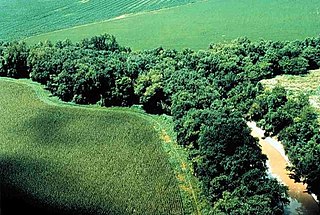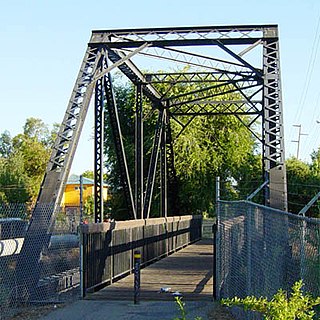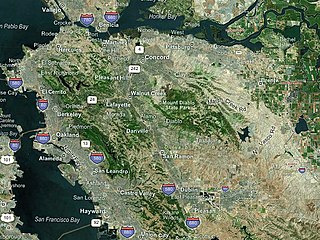| South San Ramon Creek | |
|---|---|
| Location | |
| Country | United States |
| State | California |
| Region | Alameda County, Contra Costa County |
| Cities | Pleasanton, Dublin, San Ramon |
| Physical characteristics | |
| Source | Sherburne Hills |
| - location | southeast of Danville |
| - coordinates | 37°45′56″N121°57′20″W / 37.76556°N 121.95556°W [1] |
| Mouth | Arroyo de la Laguna |
- location | Pleasanton, California |
- coordinates | 37°40′37″N121°54′44″W / 37.67694°N 121.91222°W Coordinates: 37°40′37″N121°54′44″W / 37.67694°N 121.91222°W [1] |
- elevation | 315 ft (96 m) [1] |
South San Ramon Creek is a 9.3-mile-long (15.0 km) [2] southward-flowing stream in Alameda County and southern Contra Costa County, in the East Bay region of northern California.

A stream is a body of water with surface water flowing within the bed and banks of a channel. The stream encompasses surface and groundwater fluxes that respond to geological, geomorphological, hydrological and biotic controls.

Alameda County is a county in the state of California in the United States. As of the 2010 census, the population was 1,510,271, making it the 7th-most populous county in the state. The county seat is Oakland. Alameda County is included in the San Francisco Bay Area, occupying much of the East Bay region.

Contra Costa County is a county in the state of California in the United States. As of the 2010 census, the population was 1,049,025. The county seat is Martinez. It occupies the northern portion of the East Bay region of the San Francisco Bay Area, and is primarily suburban. The county's name is Spanish for "opposite coast", referring to its position on the other side of the bay from San Francisco. Contra Costa County is included in the San Francisco–Oakland–Hayward, CA Metropolitan Statistical Area.
Contents
The creek is a tributary to Arroyo de la Laguna, flowing in the western Livermore Valley through Dublin and Pleasanton.

Arroyo de la Laguna is a 7.5-mile-long (12.1 km) southward-flowing stream in Alameda County, California, United States which originates at the confluences of South San Ramon Creek and Arroyo Mocho. The Arroyo de la Laguna is fed by tributaries in the Amador Valley and certain eastern slope drainages of the Diablo Range; these tributaries include Arroyo Valle and Sinbad Creek. Arroyo del la Laguna is the major tributary to Alameda Creek which in turn flows into the San Francisco Bay.
Livermore Valley, formerly Valle De San Jose, is a valley in eastern Alameda County, in the East Bay region of the San Francisco Bay Area, northern California.

Dublin is a suburban city of the East Bay and Tri-Valley regions of Alameda County, California, United States. Located along the north side of Interstate 580 at the intersection with Interstate 680, roughly 35 miles (56 km) east of downtown San Francisco, 23 miles (37 km) east of downtown Oakland, and 31 miles (50 km) north of downtown San Jose, it was referred to as "Dublin" in reference to the city of Dublin in Ireland because of the large number of Irish who lived there. The post office formally adopted the name in the 1890s.











